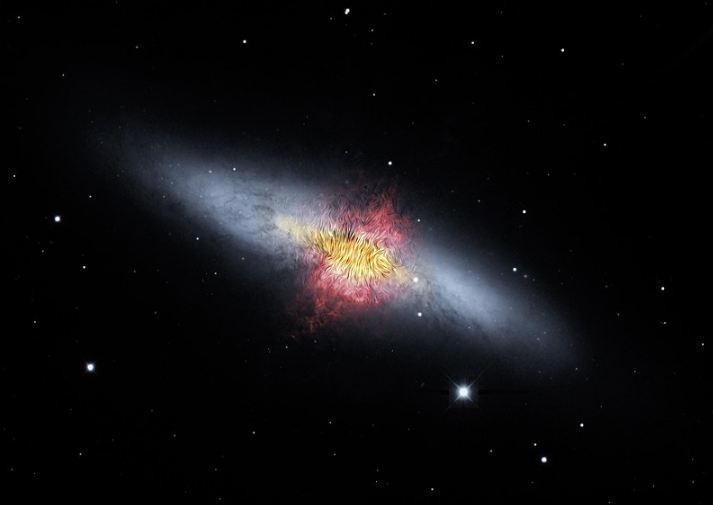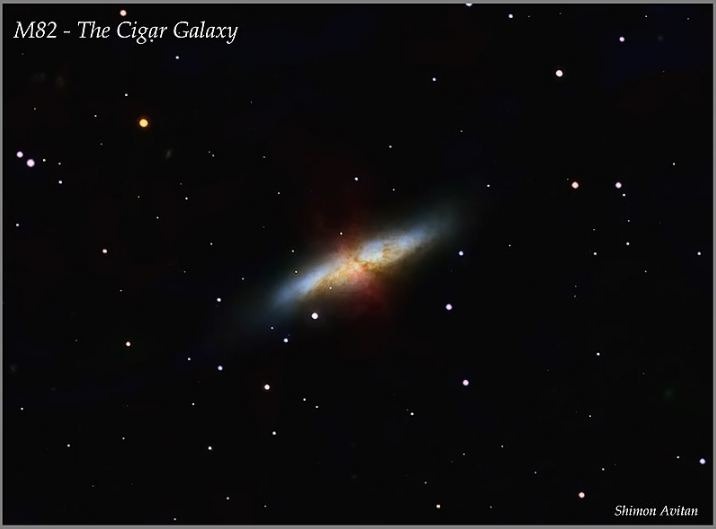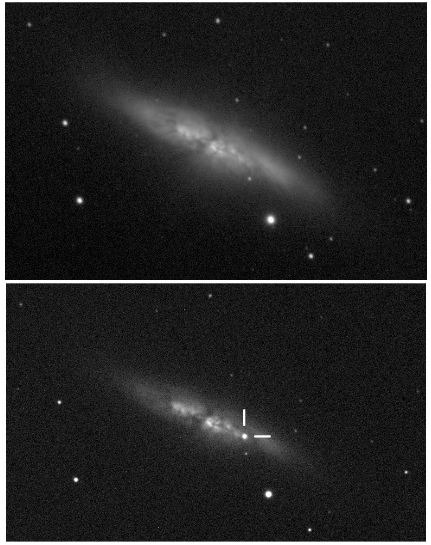While a famed French astronomer Charles Messier was hunting for celestial objects during the 18th century, he noticed several “nebulous objects” while surveying the night sky. He decided to catalog those commonly mistaken objects as comets so others would not make the same mistake. The resulting list, known as Messier Catalog, now includes over 100 objects and is one of the most influential catalogs of Deep Space Objects.
Along with discovering the Messier 81 or the Whirlpool galaxy, he also found a starburst galaxy called Messier 82 or called the “Cigar Galaxy” due to its distinctive shape. The galaxy is about 12 million light-years away in the constellation Ursa Major. This galaxy’s starburst action is thought to have been triggered by interactions with the neighboring galaxy M81 or known as Bode’s Galaxy.
The Cigar galaxy is a member of the M81 Group, including Messier 81, the irregular galaxy NGC 2366, the intermediate spiral NGC 2403, the barred spiral galaxy NGC 4236, the unbarred spiral NGC 2976, the dwarf irregular galaxy Holmberg IX, the peculiar galaxy NGC 3077, and several other galaxies located in the constellations Ursa Major, Draco, and Camelopardalis.
The galaxy’s names include Messier 82, M82, and NGC 3034. It is estimated five times more luminous than the Milky Way, and its center is one hundred times more luminous than our galaxy’s.
The interaction of the neighboring galaxy M81 is theorized to have been the cause of the starburst activity. M82 is the closest starburst galaxy to Earth and is the prototypical example of this galaxy type.
In the galaxy M82’s core area, there are 197 young massive star clusters. Images collected in 2005 by the Hubble Space Telescope revealed the clusters. The starburst activity is mainly active in the galaxy’s central region, where stars develop ten times faster than in the rest of the galaxy.
The active star-forming area in M82’s center has a diameter of around 500 parsecs.
The Cigar Galaxy got its name from its long, narrow shape and the fact that it looks ashy through small telescopes. Even though binoculars, the galaxy is bright enough to be seen.
Four high-surface-brightness aggregates in the galaxy’s core correlate to verified sources of X-ray, infrared, and radio frequencies. It’s thought they’re starburst clusters. The rate of supernovae in this area is one every ten years.
The Chandra X-ray Observatory identified flickering X-ray emissions from a point 600 light-years away from the galaxy’s center in 2006. The first discovered intermediate-mass black hole, with a 200 to 5,000 times mass of that of the Sun, is thought to be the source of emissions.
At the heart of the Cigar Galaxy is a supermassive black hole with a mass of around 30 million solar masses.
Supernova
In January 2014, a supernova was discovered in the galaxy. It was named SN 2014J, a Type Ia supernova, and was the closest type-Ia supernova discovered for 42 years. It was a serendipitous discovery by astronomer Steve Fossey and his students (Ben Cooke, Guy Pollack, Matthew Wilde, and Thomas Wright) during an undergraduate teaching session at the University of London Observatory.
By that, Fossey was teaching his students to use a small 0.35-meter (14 in) telescope at the University of London Observatory, located in Mill Hill, north London. The supernova reached an apparent magnitude of 10.5 and was the subject of an intense observing campaign by professional astronomers as it is bright enough to be seen by amateur astronomers.
SN 2014J, along with SN 1993J, discovered in Messier 81 in 1993, and SN 1987A, discovered in the fringes of the Tarantula Nebula, an H II area in the Large Magellanic Cloud in the Dorado constellation, was one of the brightest and closest supernova explosions seen in recent decades.
When too much stellar material heaps on a white dwarf, an ancient star only roughly the size of Earth but with gravitational power equivalent to that of the Sun, a Type Ia supernova is thought to occur. A white dwarf is the remaining star core that was once the size of the Sun but later expelled its outer layers of gas, forming a planetary nebula, while the core constricted into a dense orb of carbon and oxygen.
In the same year, in studying M82, scientists discovered the brightest pulsar yet known, designated M82 X-2.
Locating Messier 82
The Cigar galaxy, located 12 million light-years away, appears high in the northern spring sky in the direction of the constellation Ursa Major, the Great Bear. Perhaps the first question that comes to your mind when you hear its name as Cigar galaxy is: does this look like a cigar? According to an observation by the Advanced Camera for Surveys Wide Field Channel, the galaxy has an elliptical shape produced by its starry disk oblique tilt relative to our line of sight.
To find the Cigar galaxy, locate the Big Dipper, use the lower star closest to the “handle” in the Big Dipper bowl and draw an imaginary line between it and the Alpha – the top outside star of the asterism. Following the same trajectory, extend the line approximately 1/3 further into space, and you’ll have the approximate area!
Both M82 and a larger, brighter companion galaxy M81 are easy to spot using a finder scope or small binoculars. Under a slight magnification, the galaxies appear like two small cat’s eyes glowing in the night sky. Their relative brightness makes them stand up well to urban lighting conditions and much of the Moon interference.
Professional telescopes will reveal images showing how magnificent the starburst galaxy M82 is. You can find young stars being born ten times faster than they are inside in the Milky Way Galaxy in its central region. These new stars are too hot and emit radiation and charged particles that form the so-called stellar wind.
The stellar winds coming from these stars combine and form a galactic “superwind.” The superwind compresses gas enough to trigger millions of more stars to ignite and blast out towering plumes of hot ionized hydrogen gas above and below the galaxy’s disk.
In M82 young stars are crammed into star clusters and congregate by dozens to make the bright patches or ‘starburst clumps’ seen in the central parts of M82. The individual clusters in clumps can be distinguished only through the ultra-sharp Hubble Space Telescope.
Most of the pale objects that look like fuzzy stars sprinkled around the main body of M82 are star clusters about 20 light-years across and containing up to a million stars. If this topic interests you a lot, open the following link to learn about another interesting galaxy called the Pinwheel Galaxy.




